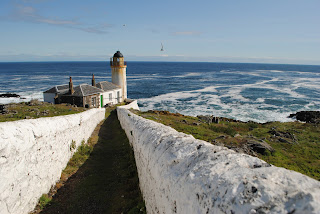 |
| The 2015 Young Birders’ Training Course participants and SOC / IoMBO leaders |
The first chance all the course participants got to meet each other was at the harbour on the morning of departure. None of us knew each other at that point; however with talk soon turning to birding and wildlife, it was clear we’d all get on well! Ourselves and our leaders from IoMBO and SOC, set off for the island soon after, filled with anticipation about the week ahead.
On
approaching the May, the cacophony of sound, as with any seabird colony, was
the first real taste of things to come. Passing beneath the westerly cliffs of
the island, we had fantastic views of Razorbill, Guillemot and Kittiwake, the
birds leaving and returning to the sheer face of the white, guano-covered
cliffs.
 |
| The Low Light by Samuel Hood |
As
the RIB pulled up to the island’s jetty and we disembarked, we were greeted by
staff from Scottish Natural Heritage (SNH) and the Centre for Ecology and
Hydrology (CEH), before heading straight to the island’s bird observatory, which
was to be our ‘home’ for the week.
The
Observatory is housed in the ‘Low Light’ (one of three lighthouses on the island),
and is the oldest continuously operating bird observatory, having maintained
its official title since its inception (apart from during the war years,
between 1939-45, when the Low Light was used as a billet for troops based on
the island).
Our setting
for the training course was therefore, pretty spectacular!
Over the
next seven days we had the opportunity to get involved in a number of the day-to-day
duties that managing a nature reserve, such as the Isle of May, entails and a
chance to develop our bird survey skills and techniques. We assisted CEH with some
of their ongoing project work, which involved for example, Puffin netting and
studying specific Puffin burrows, as well as doing a stint observing Kittiwake
colonies as part of CEH and SNH’s 24-hour nest watch study of nesting pairs.
 |
Kittiwake with SOC leader Eilidh and
course participant, Ptolemy
|
Over the
course of the week we got the chance to ring a range of different species,
including Kittiwake, Artic Tern, Puffin, Great Black-backed Gull and Starling. Others
tasks carried out during the course included constructing Tern nest boxes and
chick shelters, with the hope of encouraging Roseate Tern back to breed on the
island in the future. The team also spent a night trying to catch Storm Petrel,
without success unfortunately.
 |
| Lesser Black-backed Gull by Samuel Hood |
SOC and IoMBO’s Young Birders’ Training Course was a fantastic experience for me and one that I would highly recommend. It helped to further cement the direction I want to follow for a career in conservation and as well as providing a range of excellent experiences, spending a week on the May and staying in the Observatory with reminders of its esteemed previous visitors all around, was unsurpassable. Since the course I’ve taken steps towards getting involved in ringing as well signing up to volunteer on Fair Isle this summer and I’ve continued studying Countryside Management at college. I’d encourage anyone who is keen to further their bird skills and knowledge to apply for a place on the course.
To find out more about this funded-training course and to view and download the application form, visit the SOC website at www.the-soc.org.uk. The closing date for completed applications is 5pm on Monday 2 May 2016. You can find out more about the Isle of May Bird Observatory, here http://www.isleofmaybirdobs.org/. Samuel Hood

Sounds like an excellent experience and an excellent course.
ReplyDeleteIt must of been amazing! It's wonderful that the SOC and IoMBO have created such an inspiring experience for young birders. I think I'll apply when I'm old enough. :)
ReplyDelete